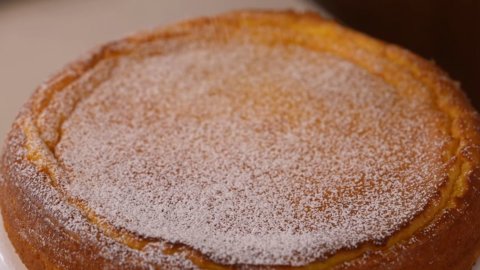Easter is approaching and the first dessert that comes to mind when talking about Neapolitan cuisine is the pastiera, the dessert of desserts which, Naples and its province, is the subject of a real tacit competition between the housewives because if the pastiera can be bought in all the pastry shops, however it is also true that "no one does it like mammà does it" and it is known that the mother is always unique.
If the pastiera is the iconic dessert for the Easter table with its many religious and pagan meanings, a tribute to spring, to life that resumes after the long winter sleep, to the awakening of nature, perceived as something intimate, familiar, which is almost part of the DNA, a real hymn to the joy of living. However, there is a poor relative of his, unacknowledged to most, who has a long history and above all a great taste of ancient things, of grandmothers' cakes, of times gone by, and he is the Migliaccio, a semolina and ricotta cake considered to be a late winter dessert, which is prepared above all for Shrove Tuesday and Easter. The name already suggests what this simple but extraordinary sweet was originally made of: the millet, a grain as old as the history of the world. Originally from the Middle East, Central Asia and India, it has been ascertained that its cultivation dates back to prehistoric times: in Italy it was found in Neolithic tombs.
Characterized by a long shelf life, it is thanks to this cereal stored in city warehouses that Venezia, besieged by the Genoese in 1378, was saved from starvation. For centuries, millet polenta was a typical dish of northern Italy, especially in Veneto, Lombardy and Trentino.
Among the Egyptians and then among the Romans, millet flour was widely used to prepare poor sweets. But the best-known preparation that has lasted for a long time over the centuries is a peasant cake made with millet and pig's blood which was prepared in conjunction with the period of pig slaughter: the pig's blood recovered from the processing of the meat was considered a complete, nutritious food and able to support the hardships of the countryside. And they weren't wrong. From a nutritional point of view, in fact, blood is composed mostly of proteins, has a high iron content, and also abounds in vitamin D and other nutrients. It is what today would be called a superfood.
But this "specialty" but it was not frowned upon by Church who considered it the heir of pagan traditions, and therefore tried to ban its use in poor cooking in Campania.
Eventually, black pudding ended up being banned for health reasons and millet ended up falling into disuse, supplanted by other more fruitful and profitable cereal crops. It survived essentially as feed for birds even if for some time now, with the rediscovery of a healthier and more aware diet, millet is returning to use above all as a cereal used in diets for people allergic to gluten.
In fact, the Neapolitan Migliaccio ended up retaining the root of the name but not the substance. Today semolina produced by grinding durum wheat semolina is commonly used instead. The basic substance has changed but not its meaning of poor sweet dedicated to the carnival and the scents of Easter. A perfume of millefiori which in some ways recalls the more famous Pastiera from which it also borrows the light color but the version with the ricotta cheese it also refers to another classic of Neapolitan pastry, the sfogliatella. It differs from the first and second in the poverty of its ingredients, but its simplicity does not come at the expense of a completely genuine and delicate flavour.
Obviously as happens when we talk about sweets of ancient tradition, even for the millet there is no certified recipe. Each family considers itself the custodian of historical truth and hands down its own from generation to generation with some personal enrichment. There are those who enrich it with candied fruit or raisins, those who perfume it with a drop of limoncello, those who replace the cow's milk ricotta with that of sheep's milk to obtain a more decisive flavour. In the Sorrento area, a revisited version of di migliaccio is made, stuffed with spaghetti from Gragnano.
The classic recipe of Neapolitan Migliaccio
Ingredients
500 ml of milk
500 ml of water
200 gr semolina
250 gr of cow's milk ricotta
200 grams of sugar
4 eggs
1 vanilla bean
1 cinnamon stick
35 g butter
1 lemon
1 orange
Icing sugar
Method
Pour the milk, the water, 50 g of sugar, the butter, the vanilla, the cinnamon, the peel of an orange and a lemon into a saucepan. Heat over medium heat, stirring with a ladle until the butter has melted. Slowly add the rain semolina not to create lumps. Keep stirring for about ten minutes until you get a mixture that in some ways resembles polenta and until the mixture detaches from the sides of the pan. Remove the citrus peels and leave to rest covered with a cloth.
Beat the eggs with the sugar in a bowl with the aid of an electric whisk. Add the finely grated orange and lemon peels. When the dough has reached a frothy consistency, proceed by adding the sieved cottage cheese by means of a sieve and then the semolina. Blend everything with an electric whisk to mix all the components of the dough (adding a few drops of Millefiori aroma to personal taste. At this point, all that remains is to pour everything into a pan with high sides lined with greased and floured parchment paper and bake in the oven at an average temperature of 180 degrees for about fifty minutes until the surface of the cake has acquired a nice golden colour. Turn off the oven and leave the Migliaccio to rest with the door half open. You will have to wait at least an hour before remove the cake from the mould frenzy of gluttony the best thing is to consume the Migliaccio the day after, it will acquire moisture, flavors and aromas.





